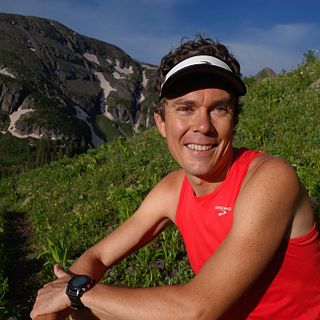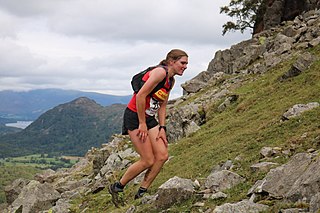
The marathon is a long-distance foot race with a distance of 42.195 km, usually run as a road race, but the distance can be covered on trail routes. The marathon can be completed by running or with a run/walk strategy. There are also wheelchair divisions. More than 800 marathons are held throughout the world each year, with the vast majority of competitors being recreational athletes, as larger marathons can have tens of thousands of participants.

An ultramarathon, also called ultra distance or ultra running, is a footrace longer than the traditional marathon length of 42.195 kilometres. Various distances, surfaces, and formats are raced competitively, from the shortest common ultramarathon of 31 miles (50 km) and up to 3100 miles. World Championships are held by the International Association of Ultrarunners (IAU) for 50 km, 100 km, 24 hours, and ultra trail running. The Global Organization of Multi-Day Ultramarathoners (GOMU) holds World Championships for 48 hours and 6 days. World Records are ratified and recognized by World Athletics, the IAU, and by GOMU.

Trail running is a type of running that takes place on outdoor trails, often in mountainous terrain, and often includes significant ascents and descents. Trail running is overseen by the International Trail Running Association (ITRA) and includes longer races.

Dean Karnazes, is an American ultramarathon runner, and author of Ultramarathon Man: Confessions of an All-Night Runner, which details ultra endurance running for the general public.

The Badwater Ultramarathon is a 135-mile (217 km) Ultramarathon race starting at −282 feet (−86 m) below sea level in the Badwater Basin, in California's Death Valley, and ending at an elevation of 8,360 feet (2,550 m) at Whitney Portal, the trailhead to Mount Whitney. It takes place annually in mid-July when the weather conditions are most extreme and temperatures can reach 130 °F (54 °C).

The Western States Endurance Run, known commonly as the Western States 100 or Western States, is a 100.2-mile (161 km) ultramarathon that takes place on California's Sierra Nevada Mountains trails each year on the last full weekend of June. Western States is the oldest and one of the most competitive ultramarathons in the United States, and is administered by the nonprofit Western States Endurance Run Foundation.

Scott Gordon Jurek is an American ultramarathoner, author, and public speaker. Throughout his running career, Jurek was one of the most dominant ultramarathon runners in the world, winning the Hardrock Hundred (2007), the Badwater Ultramarathon, the Spartathlon, and the Western States 100 Mile Endurance Run (1999–2005). In 2010, at the 24-Hour World Championships in Brive-la-Gaillarde, France, Jurek won a silver medal behind Shingo Inoue and set a new US record for distance run in 24 hours with 165.7 miles. In 2015, Jurek set the Fastest Known Time running record for the 2,189-mile Appalachian Trail.

The Hardrock Hundred Mile Endurance Run is an ultramarathon 100.5 miles (161.7 km) in length, with 33,000 feet (10,000 m) of climb at an average elevation of over 11,000 feet (3,400 m). The race is held on a loop course on 4WD roads, dirt trails, and cross country in Southern Colorado's San Juan Range, US. The race is dedicated to the memory of the miners who settled in the area and who built the mining trails on which much of the race is run. The race is directed by Dale Garland.
Multiday races are ultramarathon running events which are typically either segmented into daily events of a specified distance or time, or staged so that runners can run as far as they want, at their own discretion, over a set course or over a set number of days. Multiday races can range from continuous 48-hour track events to staged transcontinental treks.

The Leadville Trail 100 Run is an ultramarathon held annually on rugged trails and dirt roads near Leadville, Colorado, through the heart of the Rocky Mountains. First run in 1983, the race course climbs and descends 15,600 feet (4,800 m), with elevations ranging from 9,200 to 12,620 feet. In most years, fewer than half the starters complete the race within the 30-hour time limit.
Tim Twietmeyer is an Auburn, California-based ultramarathon runner and an engineering manager at Hewlett Packard, in Roseville in the U.S. state of California. Twietmeyer is also a mountain biker, road cyclist, and retired almost-scratch golfer and swimmer. He is best known for his five victories and unprecedented 25 sub-24 hour finishes at the 100-mile (160 km) Western States Endurance Run.
William Morley Sichel is a British long-distance runner.
Amy Palmiero-Winters is a below-knee amputee who currently holds eleven world records in various events. In 2010, she was awarded the James E. Sullivan Award as the top amateur athlete in the United States and the ESPN ESPY Award as the top female athlete with a disability in the world.
Eleanor Robinson is a British former ultramarathon runner and two-time winner of the IAU 100km World Championships. She was the first woman to run over 150 miles in a 24-hour endurance race. She was the winner of the first Badwater Ultramarathon in 1987. She was twice bronze medallist at the IAU 100 km European Championships.

Jasmin Karina Paris is a British runner who has been a national fell running champion and who has set records for the Bob Graham Round and the Ramsay Round. In 2024, she was the first woman to successfully complete the Barkley Marathons.
The backyard ultra or last one standing is a form of ultramarathon race where competitors must consecutively run the distance of 6.706 kilometres (4.167 mi) in less than one hour, which is a pace of 100 miles per 24 hours. The race is over when only one runner remains to complete a lap. This runner is marked as the winner and only finisher, with all other runners receiving a "DNF". The runner who completes the second-most laps in a race is often referred to as the "assist", in the sense that their effort is ultimately what determines how long the race is allowed to continue--there is no predefined end length or time in a backyard ultra, as long as multiple runners can complete each loop within an hour.

Carol Morgan is an Irish ultrarunner, who specialises in non-stop mountain ultramarathons 100 km and longer, often in challenging conditions with significant ascents / descents. Born in Dublin in 1973, where she trained as a nurse, she is an advanced practitioner in emergency medicine. Morgan holds the course record for endurance ultra event, the Kerry Way Ultra.
Big's Backyard Ultra is the original backyard ultra, invented by Gary "Lazarus Lake" Cantrell of Bell Buckle, Tennessee. Participants run a 4.167-mile loop every hour, and are eliminated if they fail to complete a loop in an hour. The path of the loop is on trails during the day and along a road after dark. The distance of each loop is equal to 100 divided by 24, so that a competitor runs 100 miles for a full day of competition. There is no predefined finish. The winner is the competitor who completes a loop that no other competitors complete. If no competitor outlasts every other competitor, there is no winner.

Gary Cantrell, known as Lazarus Lake, is an endurance race designer and director. His races include the Barkley Marathons, Big's Backyard Ultra, the Barkley Fall Classic, Vol State 500K, A Race for the Ages, the Last Annual Heart of the South, and the Strolling Jim 40. In 2018, Lake covered the United States on foot, starting in Rhode Island and ending in Oregon.
John Wade Kelly is an American endurance athlete who specializes in ultrarunning.













